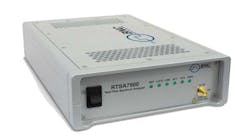Real-time spectrum analyzers can add a great deal of measurement power and versatility to a test setup, but often are beyond the limits of many budgets. Fortunately, the RTSA7500 real-time spectrum analyzer series from Berkeley Nucleonics includes four models—with frequency ranges to 27 GHz and real-time bandwidths as wide as 100 MHz—all at reasonable price points.
As with many newer spectrum analyzers, the RTSA7500 instruments are supplied in compact housings (see figure). They leverage the processing and display capabilities of personal computers (PCs) to process and show measurement results while helping to save customers on the final price.
The four models are the RTSA7500-8B, with measurement range of 100 kHz to 8 GHz and maximum real-time bandwidth of 10 MHz; the RTSA7500-8, with measurement range of 100 kHz to 8 GHz and maximum real-time bandwidth of 100 MHz; the RTSA7500-18, with measurement range of 100 kHz to 18 GHz and maximum real-time bandwidth of 100 MHz; and the RTSA7500-27, with measurement range of 100 kHz to 27 GHz and maximum real-time bandwidth of 100 MHz.
The spectrum analyzers include a +12-VDC power input port for running on automotive and vehicular power supplies. Also, they can work with 10-MHz external references as well as their own internal frequency reference. The analyzers can be used locally as well as remotely, via software and Internet control. The RTSA7500 real-time spectrum analyzers are also available from Saelig Co., Berkeley Nucleonics’ U.S. technical distributor.
Berkeley Nucleonics Corporation, 2955 Kerner Blvd., San Rafael, CA 94901; 415-453-9955, FAX: 415-453-9956
